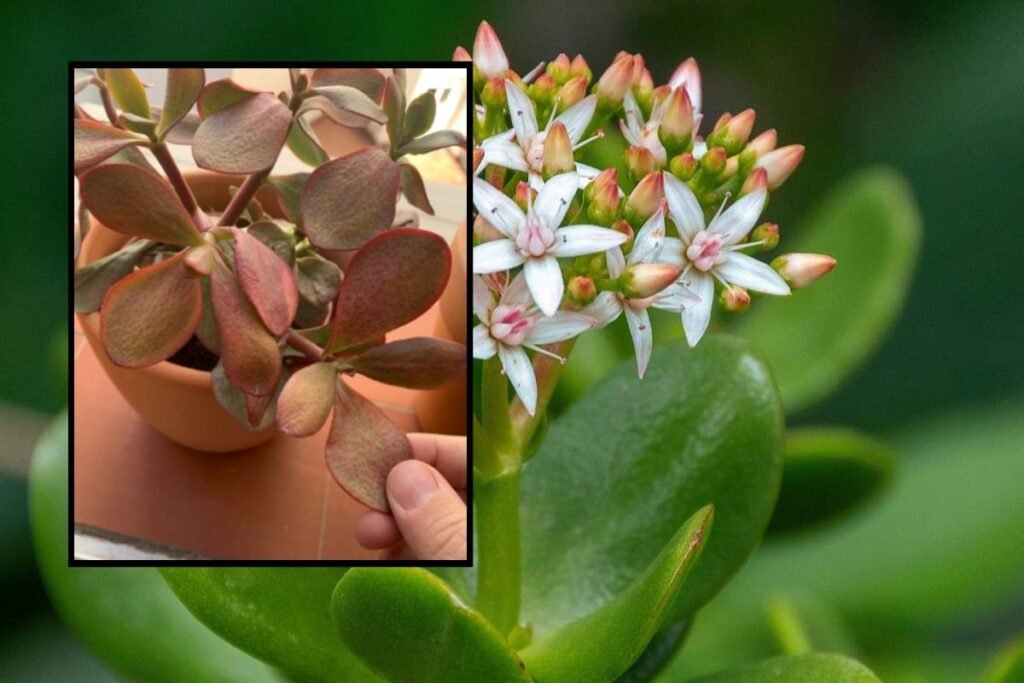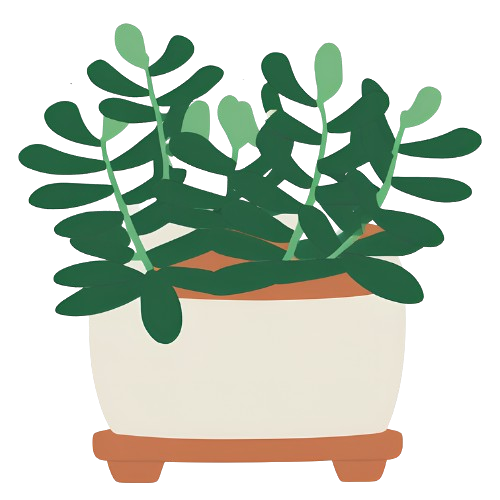Have you noticed your jade plant’s leaves turning red? Don’t worry! This common change doesn’t always mean something is wrong. In fact, it often signals that your plant is responding to its environment in natural ways.
I’ve cared for many jade plants over the years and have seen this reddening happen under various conditions. Let’s explore why jade plants turn red and what you can do about it if needed.
Table of Contents
What Makes Jade Plant Leaves Turn Red?

Jade plants (Crassula ovata) normally have thick, oval green leaves. Yet these leaves can turn red or develop red edges. This happens for several reasons. Most of the time, this color change is not harmful. It shows the plant is adjusting to its surroundings.
The main causes include:
- Too much sunlight
- Temperature stress
- Lack of water
- Nutrient issues
- Natural aging
- Seasonal changes
Let’s look at each one more deeply.
Sunlight Exposure: The Main Cause
The most common reason jade plants turn red is too much direct sunlight. Jade plants need some sun, but too much can stress them. The plant responds by making anthocyanin, a reddish pigment that acts like a natural sunscreen.
Think of it as your plant putting on sunblock! When jade plants get too much intense light, they produce these red pigments to protect their cells from damage. This is most common in summer when light is strongest.
If you’ve moved your jade plant to a brighter spot, or if seasonal changes have increased the light it gets, you’ll often see red edges appear on the leaves. The side facing the light often turns redder than the side away from light.
While some sun stress can make your plant look more colorful and is not harmful, extreme sun exposure can damage your plant. If the leaves start to look burned or develop brown spots, that’s too much sun.
How Temperature Affects Jade Plant Color
Cold temperatures can also cause your jade plant’s leaves to turn red. Jade plants come from South Africa where temperatures stay fairly warm. When exposed to cold (especially below 50°F or 10°C), jade plants may develop red tips or edges.
This color change helps the plant cope with cold stress. The red pigment may help protect the plant cells from cold damage. Many succulents show this response to cold.
In fall and winter, you might notice more red tones in your jade plant. This is normal as the temperatures drop. If kept outdoors, jade plants often show more red coloring in winter months.
Water Stress and Reddening
Drought stress can cause jade plant leaves to turn red. When jade plants don’t get enough water, they conserve resources by producing those protective red pigments.
The plant does this to:
- Reduce water loss
- Protect itself from increased sun exposure (since dry soil often happens during sunny periods)
- Signal stress to change its metabolism
While jade plants are drought-tolerant, long periods without water can trigger this response. The leaves may also become thinner and less plump when underwatered.
Nutrition and Soil: Hidden Factors
Poor soil nutrients can cause jade plants to turn red. Specifically, phosphorus deficiency often leads to reddish leaves in many plants, including jade plants.
The soil pH matters too. If the soil is too acidic or too alkaline, the plant may not absorb nutrients properly, leading to red leaves. Jade plants prefer slightly acidic to neutral soil (pH 6.0-7.0).
Overfertilizing can also cause stress, showing up as red leaves. Too much nitrogen can burn roots and cause leaf discoloration. Jade plants need very little fertilizer compared to other houseplants.
Natural Aging Process
As jade plant leaves age, they sometimes develop red edges. This is a natural part of the leaf aging process. Older leaves at the bottom of the plant often show this change first.
These older leaves will eventually fall off as new growth develops. This normal shedding process helps the plant direct energy to new growth. Don’t worry if older leaves turn red and drop off, as long as the plant continues to produce new, healthy growth.
Seasonal Color Changes in Jade Plants
Jade plants often change color with the seasons. Many owners notice their plants develop red edges in summer and winter, then return to fully green in spring and fall.
These changes follow the plant’s natural growth cycle:
- Summer: Red edges from sun exposure
- Fall: Return to green as light intensity decreases
- Winter: Red tones from cold stress and shorter days
- Spring: Bright green growth as the plant enters active growing phase
These seasonal changes are perfectly normal and healthy. In fact, some jade plant varieties are bred specifically to show more red coloration.
Is Red Coloration Harmful to Jade Plants?
In most cases, no. Red coloration is usually a sign that your plant is adapting to environmental conditions. It’s a natural response that helps protect the plant.
However, extreme redness along with other signs of stress might indicate problems:
- Red and wrinkled leaves often mean underwatering
- Red leaves that are soft or mushy suggest overwatering
- Red leaves with brown, crispy areas show sun damage
- Red leaves dropping off in large numbers may signal various stresses
Think of red coloration as your plant communicating with you. It’s telling you about its environment. When combined with other symptoms, it helps you figure out what changes you need to make.
How to Fix Red Jade Plant Leaves (If Desired)
If you prefer the classic green look of jade plants, you can take steps to reduce the red coloration. Here’s what to do based on the cause:
For Sun-Induced Redness:
Move your plant to a spot with bright indirect light instead of direct sun. Eastern windows work well, or place the plant a few feet away from southern or western windows. You can also use sheer curtains to filter intense light.
Give your plant time to adjust. The red color won’t disappear right away. New growth should come in green, and over weeks or months, the plant will return to its greener state.
For Temperature-Related Redness:
Keep your jade plant in a stable, warm environment. Ideal temperatures range from 65-75°F (18-24°C) during the day and not below 50°F (10°C) at night.
Move plants away from cold drafts or air conditioner vents. In winter, keep jade plants away from cold windows.
For Water-Related Redness:
Develop a consistent watering routine. Allow the soil to dry completely between waterings, then water thoroughly until it flows from the drainage holes.
For indoor jade plants, this usually means watering every 2-3 weeks, depending on conditions. Check the soil by inserting your finger 1-2 inches deep – if it’s dry, it’s time to water.
For Nutrient-Related Redness:
Repot your jade plant in fresh, well-draining cactus or succulent soil if you suspect nutrient problems. Add a small amount of balanced, diluted fertilizer during the growing season (spring and summer).
Use fertilizer at 1/4 to 1/2 the recommended strength, applying only once every 2-3 months. Jade plants need very little fertilizer.
When Red Leaves Are Desirable
Many plant owners actually prefer jade plants with red-tinged leaves! This coloration can add visual interest and show that your plant is getting adequate light. Some jade plant varieties naturally show more red coloration.
If you like the red tones, provide:
- A few hours of direct morning sun
- Slightly less frequent watering (while still maintaining healthy, plump leaves)
- Cooler nighttime temperatures when possible
- Good air circulation
You can encourage moderate stress to maintain the red color without harming your plant’s health.
The Science Behind the Red Color Change
The red pigment in jade plants comes from anthocyanins. These pigments appear when the plant experiences certain stresses. They serve several purposes:
- They act as “sunscreen,” absorbing harmful UV rays and protecting plant cells
- They work as antioxidants, neutralizing damaging free radicals
- They help regulate the plant’s internal temperature
- They may deter pests by making the plant less appetizing
This color change is a perfect example of plant adaptation. Instead of running away from stress (like animals can), plants adapt by changing their chemistry and physiology.
General Jade Plant Care for Health

To keep your jade plant healthy regardless of color:
Soil and Potting
Use well-draining soil specifically made for cacti and succulents. You can make your own by mixing regular potting soil with coarse sand or perlite (about 2 parts soil to 1 part sand/perlite).
Choose a pot with drainage holes. Terracotta pots work well because they allow soil to dry more quickly, reducing the risk of overwatering. Don’t use pots that are too large – jade plants prefer to be slightly pot-bound.
Watering Wisdom
The top cause of jade plant problems is overwatering. These succulents store water in their leaves and can go longer between waterings than most houseplants.
Water thoroughly when the soil is completely dry, then allow all excess water to drain away. Never let your jade plant sit in water. In winter, reduce watering even more as the plant enters a semi-dormant state.
Light and Location
Jade plants need bright light to thrive. They can adapt to lower light, but growth will be slower and leaves may stretch toward light sources (becoming “leggy”).
Ideal locations include:
- East-facing windows (morning sun)
- South or west windows with filtered light
- Bright rooms with indirect light
Rotate your plant every few weeks to encourage even growth on all sides.
Seasonal Care
Adjust your care with the seasons:
- Spring/Summer: More frequent watering, some fertilizer, protection from intense afternoon sun
- Fall/Winter: Reduced watering, no fertilizer, protection from cold drafts
Jade plants can go outdoors in summer in many climates, but introduce them gradually to outdoor conditions to prevent shock.
Propagating Your Jade Plant
One of the best things about jade plants is how easy they are to propagate! If your jade plant has developed an interesting color pattern, you might want to grow more plants with that same characteristic.
To propagate from leaf cuttings:
- Gently remove a healthy leaf, twisting it from the stem
- Let the leaf callus over for 1-2 days
- Place it on top of well-draining soil
- Mist occasionally but don’t overwater
- Within weeks, tiny roots and a new plant will form
To propagate from stem cuttings:
- Cut a stem section 2-4 inches long
- Remove lower leaves, leaving a few at the top
- Let the cutting dry for 2-3 days until the cut end forms a callus
- Plant in slightly damp succulent soil
- Wait 2-3 weeks before regular watering
Propagated plants often show characteristics of the parent plant, including color tendencies.
Common Jade Plant Problems Beyond Red Leaves
While red leaves are usually not a problem, other issues might affect your jade plant:
Yellow Leaves
This often indicates overwatering. Check the stems for softness, which can signal rot. Reduce watering and ensure good drainage.
Dropping Leaves
Jade plants sometimes drop leaves due to:
- Sudden temperature changes
- Moving to a new location
- Overwatering or underwatering
- Natural aging of lower leaves
A few falling leaves is normal, but mass leaf drop needs attention.
Shriveled Leaves
Wrinkled, shrunken leaves usually mean underwatering. Give your plant a good soak, and the leaves should plump up again within a day or two.
Pests
Watch for mealybugs (white cotton-like spots) and spider mites (fine webbing). Treat infestations with insecticidal soap or neem oil, applied according to package directions.
Jade Plants in Different Environments
The amount of redness your jade plant shows will vary based on where you grow it:
Indoor Jade Plants
Indoor plants typically show less red coloration unless placed in direct sun. The controlled environment means less stress from temperature or light extremes.
Outdoor Jade Plants
Jade plants grown outdoors often develop more intense red coloration due to:
- Stronger sunlight
- Temperature fluctuations
- Wind exposure
- Natural rainfall patterns
In mild climates (USDA zones 9-11), jade plants can live outdoors year-round and may develop beautiful red highlights, especially in winter.
Office or Low-Light Environments
Jade plants in offices or low-light areas rarely develop red leaves. They may grow more slowly and stay completely green. If your jade plant needs more light, it will become “leggy” with stretched stems reaching toward light sources.
Cultural Significance of Jade Plants
Jade plants are known as “money plants” or “lucky plants” in some cultures. Their round leaves symbolize coins and prosperity. In feng shui, jade plants are believed to attract wealth and friendship when placed in the right location.
The red coloration might even be considered auspicious in some traditions, as red often symbolizes good fortune and joy in Chinese culture. So if your jade plant develops red leaves, some might see it as an especially lucky sign!
Final Thoughts on Red Jade Plant Leaves
Red coloration in jade plants is usually not a cause for concern. It represents your plant’s natural adaptation to its environment, particularly to light, temperature, and water conditions.
By understanding what causes these color changes, you can decide whether to:
- Embrace the red tones as a sign of a well-adapted plant
- Adjust conditions to encourage the classic green appearance
- Fine-tune your care to balance green and red for visual interest
Remember that slight stress (leading to red edges) can actually make your plant more resilient and may enhance its appearance. But always watch for signs of extreme stress that might harm your plant.
With the right care, your jade plant can live for decades, growing into a beautiful indoor tree that adapts to your home’s conditions. Whether green, red-tinged, or somewhere in between, jade plants remain one of the most rewarding and forgiving houseplants you can grow.
So next time you notice your jade plant turning red, you’ll know exactly what’s happening and what (if anything) you need to do about it!

My name is Shahriar Robin, and I’m the creator of JadePlants.org. Growing up in a village, I developed a deep connection with nature from a young age. Plants and gardening have always been a part of my life, and jade plants, with their resilience and elegance, have held a special place in my heart. Over the years, I’ve learned so much about these fascinating plants, and I created this site to share that knowledge with you—completely free of charge.

